For most people, when they think about 3D prints, they often associate it with smaller objects such as an action figure, a small boat, or perhaps a tiny model of your house. But there are times when large-scale printers make more sense. The problem is that 3D printers with a huge build volume often means you pay an arm and a leg for the privilege of owning it.
Not with the Anycubic Chiron. This 3D printer shows the world that bigger printers need not be expensive. It’s priced at less than $500 but offers a wide range of features that you will typically find in an excellent 3D printer today. Plus it allows you to print bigger things.
Sounds like it’s too good to be true? Read on and find out. We will touch on the features and reasons why Anycubic Chiron is more than worth its price. We will also explore some alternatives to the Chiron, as well as help you decide on whether to buy this 3D printer or not.
The Anycubic Chiron 3D printer has a build volume of 15.7 by 15.7 by 17.7 inches (400 by 400 by 450 millimeters) allowing you to print large scale models with ease. What’s more, the printing platform works with most filaments. Your prints will adhere to the heated bed with ease, while it’s easy to pry them off the platform when it’s cold.
The short-distance extruder allows for a smooth release of the melted filaments. This process allows the printer to ensure higher print accuracy between 0.002 to 0.012 inches (0.05 to 0.3 millimeters).
This printer comes with a full-color touch display that allows you to control the settings and operate your printer. The user interface is intuitive and easy to figure out.
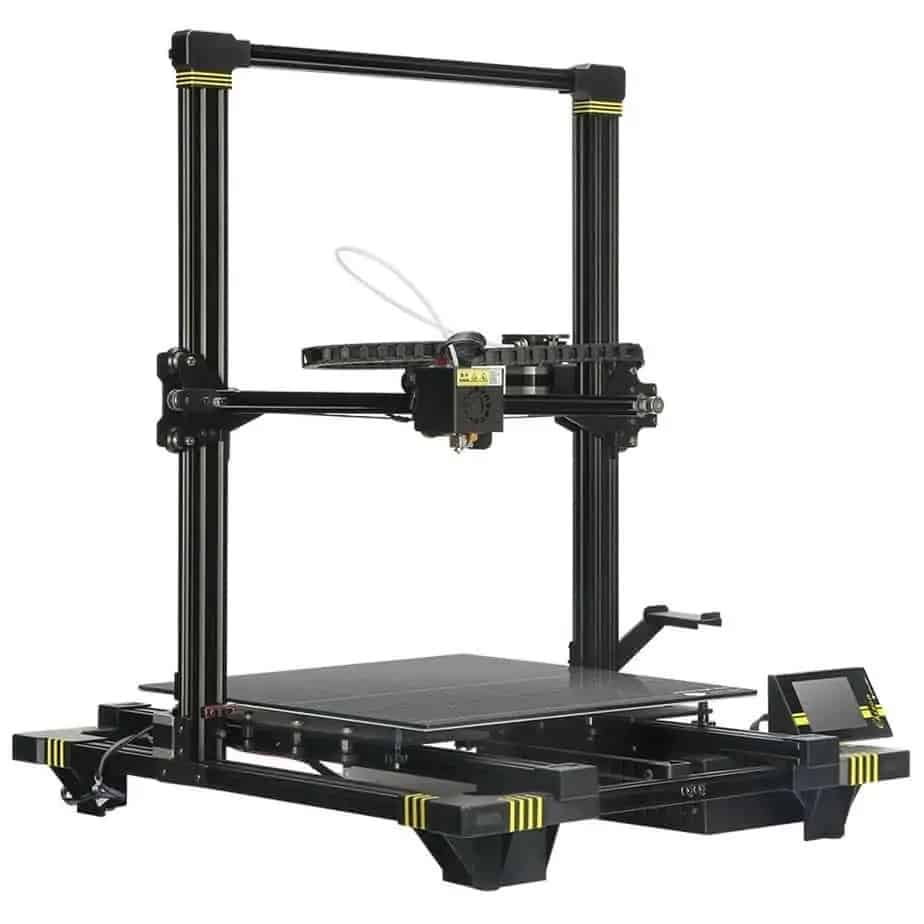
The Anycubic Chiron also comes with a filament sensor that will alert you if the printer runs out of filament or if it breaks while printing. Other features that you should know about the Anycubic Chiron include:
- Technology: Fused Deposition Modeling
- X, Y, Z positioning accuracy rated at 12.5, 12.5, and 2 microns
- Nozzle diameter: 0.016 inches (0.4 millimeters)
- Print speed: 0.79 to 3.94 inches per second (20 to 100 millimeters per second)
- Compatible materials: PLA, ABS, HIPS, Wood, TPU
- Ambient Operating Temperature: 46.4 to 104 degrees Fahrenheit (8 to 40 degrees Celsius)
- Maximum extruder temperature: 500 degrees Fahrenheit (260 degrees Celsius)
- Connectivity: Memory card and data cable
Pricing
Anycubic Chiron sells for around $430 and that comes with a pound (0.5 kilograms) of PLA filament. You can opt to order the printer with 5.5 pounds (2.5 kilograms) of filament for $50 more.
What’s in the Box
The Chiron comes to you with a bit of assembling necessary. The good news is that putting it together will take you 30 minutes to 1 hour at most. Plus, the package gives you everything you need to assemble the 3D printer, including:
- 10 M5 Screws
- Glove
- PLA Filament
- Pliers
- Power cord
- Scraper
- SD card
- SD Card reader
- Tool set
- Tweezer
- USB cable
- User manual
What You Would Like About the Anycubic Chiron
The Ultrabase Pro print bed with its microporous coating can really hold on to your models so they don’t topple over while printing is in progress. Plus, unlike other heated beds with a good hold, it’s easy to pry off the finished prints after you have let the bed cool down completely.
What’s more, the Anycubic Chiron works with a wide assortment of filaments so you can use the materials that you need. Everything is easy to do, from assembly to printing.
But this printer’s main selling point is the huge build volume without the expected expensive price tag.
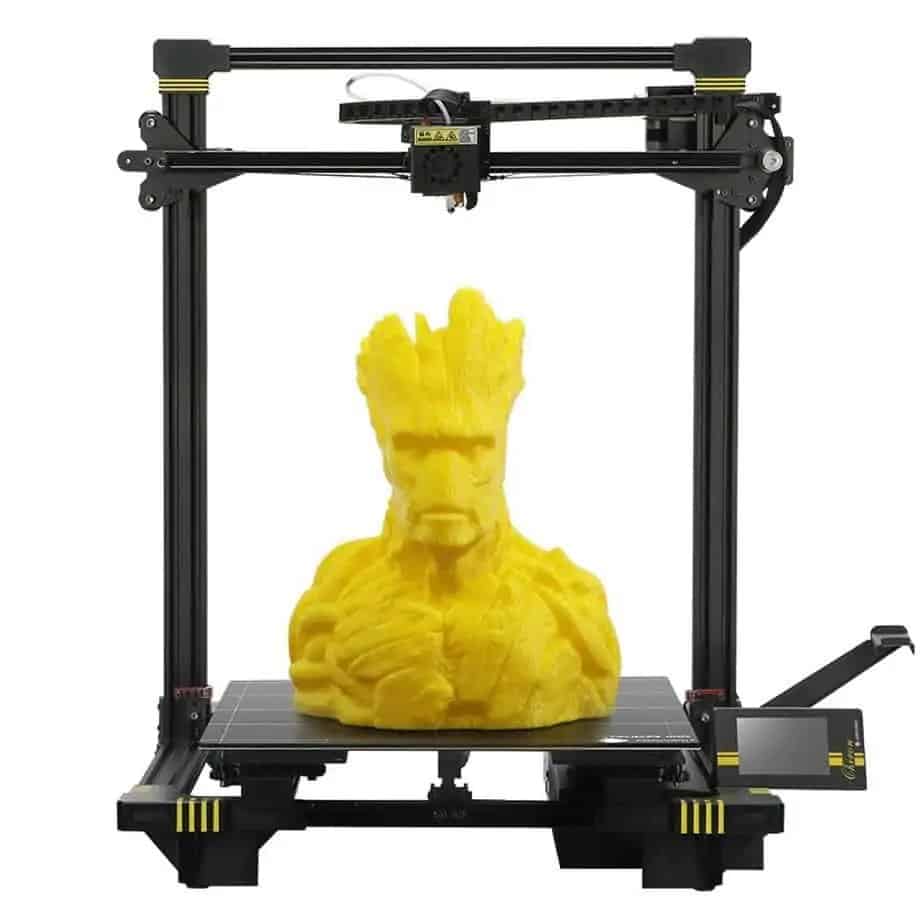
What Might Turn You Off from the Anycubic Chiron
For those who feel clumsy, you might want to skip on the Chiron as you will need to assemble it before you can use it. The good news is that it’s pretty easy to figure out how to assemble the machine and the instructions help too.
While this printer offers automatic bed leveling, there are some issues. For one, you will need to manually adjust the bed first to make sure that it’s level. Calibrating the bed can be quite a pain as well, so it’s a shame that the auto bed leveling is not up to par with some of Chiron’s competitors.
Pros
- Huge build volume
- Removable stepper drivers
- Ultrabase Pro bed is excellent
- Intuitive user interface and touch display
Cons
- Loud fans
- Auto leveling needs work
Anycubic Chiron: The Bottom Line
The Anycubic Chiron gives you the chance to print large models without any problem. This printer has one of the biggest build volumes you can find right now. And because of that, you should know that you will need a big space to accommodate it as well.
Fully assembled, this printer measures 25.6 by 24.1 by 28.3 inches (651 by 612 by 720 millimeters). That’s right, it’s more than two feet all around.
There are some issues with the automatic bed leveling, but it’s something that you can probably remedy by doing what the manufacturer: do the adjustments manually at first.
Print quality can be excellent if you can find the right profiles for this printer. And with its below-$500 price tag and huge build volume, you will not regret buying this 3D printer.
Alternatives to the Anycubic Chiron
For those people who like to have their 3D printers come to them fully assembled, you should look at these products. The same goes for those who are looking for an alternative to the Chiron.
The good news is that there are options for you. In fact, there is quite a handful of 3D printers that offer huge build volumes at different price points.
With a jaw-dropping price tag at $6,000, Raise3D Pro2 Plus is sure to raise some eyebrows. However, all indicators seem that it has enough features and good things to justify that price.
For one, this 3D printer gives you a huge build volume of 12 by 12 by 23.8 inches (305 by 305 by 605 millimeters). While it can’t match the width and depth of prints that the Chiron can give you, it certainly allows you to significantly taller 3D objects.
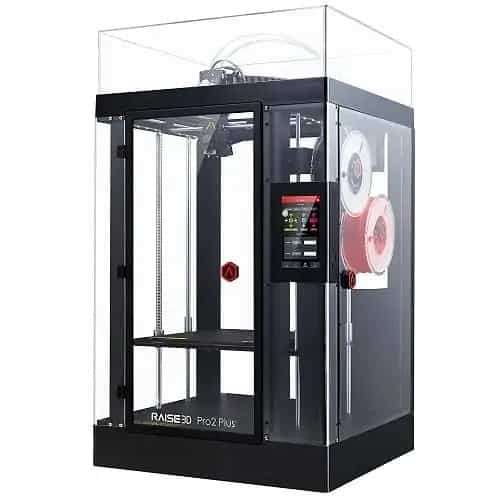
What’s more, the Raise3D Pro2 Plus comes with electronic extruders. These dual extruders have retracting hot ends that can print even the most complicated parts. Plus you can also use multiple filaments.
This printer also uses interchangeable nozzles with diameters of 0.008 inches (0.2 millimeters) that translates to even finer details. This is also a very accurate and precise 3D printer with astounding print quality. It boasts of a layer resolution of 0.01 millimeters.
You will also like the seven-inch touchscreen on this printer, which allows you to easily control the printer, change the settings, and see what’s going on. You can review the status of the printing, even see how much work has been done so far, as well as get other information that you may need.
Further, because the extruders can get as hot as 572 degrees Fahrenheit (300 degrees Celsius), it works with more filaments such as:
- ABS
- ASA
- HIPS
- Nylon
- PC
- PETG
- PLA
- PP
- PVA
- TPE
- TPU
- Carbon fiber infused
- Glass fiber infused
- Metal fill
- Wood fill
You can also do things wirelessly such as upload a design to the printer over the air. You can also control and monitor your prints even when you’re halfway across the world. The 3D printer also safeguards the air quality in the room where it’s working with the HEPA air filter included in the machine.
Lastly, you’d like the excellent build plate system that is made with aerospace-grade aluminum. This plate system can get very hot to ensure better adhesion.
Pros
- Resumes printing after a power loss
- Tells you when you’ve run out fo filament
- Can be accessed, tracked, and controlled remotely
- connectivity options include Wi-Fi, USB port, live camera, and LAN
- Works with a wide assortment of filaments
- Consistently excellent print quality
- The fully enclosed print area for better heat management
- Integrated software
- Heated magnetic aluminum bed
- HEPA filter
Cons
- Expensive
- Has a large footprint measuring 24.4 by 23.2 by 43.5 inches (620 by 590 by 1,105 millimeters)
The Modix Big-60 gives you a huge build volume at 23.62 by 23.62 by 23.62 inches (600 by 600 by 600 millimeters). That’s roughly two feet all around and that’s definitely larger than the build volumes of both Anycubic Chiron and Raise3D Pro2 Plus. It retails at $3,700.
You will need to assemble it yourself and it might require a couple of people to finish. Fully assembled, this machine measures 36 by 42 by 53 inches (906 by 1,060, by 1,356 millimeters) so you need to earmark space for this printer.
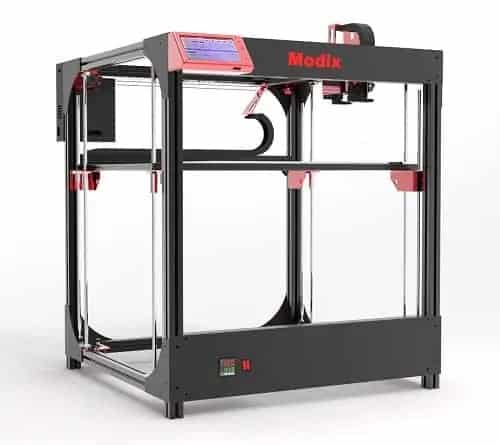
The Modix Big-60 has gone through three iterations. The latest version 3 comes with a lot of new features that you will love. You get a professional 3D printer that has a black and red color scheme. It uses high-quality aluminum and other quality materials for its construction and the V3 has the E3D Aero extruder.
This printer has one extruder, but you can set it up so that it can work with a dual-extruder setup that allows you to print with two filaments.
The V6 Volcano hot end features interchangeable nozzles. The printer can work with a variety of materials, even the rare and exotic ones. What’s more, you can fit it with different nozzles as long as the diameter falls between 0.02 to 0.05 inches (0.4 to 1.2 millimeters).
The touchscreen interface is huge at seven inches. You can use the interface to operate the printer, as well as to see the status of your prints in real-time. the Modix Big-60 can also connect to your Wi-Fi network, allowing you to control the machine from your computer or mobile phone.
Pros
- Automatic bed leveling
- One of the largest build volumes around
- Heated bed featuring a dual-zone heater
- Filament sensor
Cons
- Expensive
- Needs to be assembled
Modix BIG-60 V3 3D Printer Kit | Matter Hackers
Offering a print volume of 600 x 600 x 660 mm (23 x 23 x 25” in) this self-assembly 3D printer kit is the most cost-effective option for achieving your large 3D printing goals.
The second version of the Creality CR-10S Pro gives you a build volume of 11.8 by 11.8 by 15.7 inches (300 by 300 by 400 millimeters), which is smaller than the build volume you see on the Anycubic Chiron. Plus at $630, this 3D printer is more expensive as well.
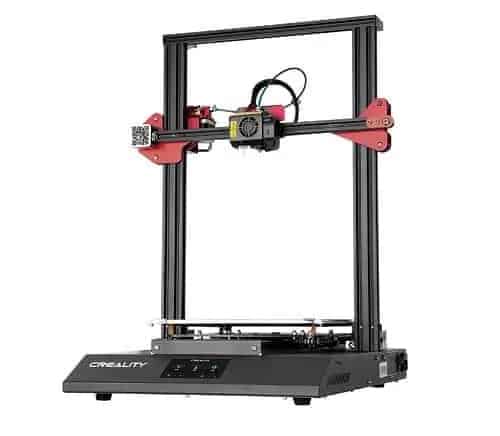
But why is it on this list despite the smaller build volume and more expensive price tag? It’s because this 3D printer is known to be reliable and powerful.
For one, it looks great with its sleek and modern design. the wires are safely hidden away so it doesn’t look cluttered. Printing on the Creality CR-10S Pro V2 is also very easy.
The printer comes with a powerful 480-watt Mean Well power supply, Capricon filament tubing that is heat resistant, a filament sensor, and an easy to understand user interface. This printer can also resume printing
Pros
- Automatic bed leveling
- Mean Well power supply
- Easy to use
Cons
- Some placements are not intuitive, such as the power switch located towards the back and the input slots are placed towards the front
- Your print sometimes stick to the print bed
Frequently Asked Questions
In this section, we try to answer some of the questions that readers often ask us about large 3D printers.
1. Aside from the Anycubic Chiron, are there any other large 3D printers that sell for less than $1,000?
You have options like the Tronxy X5ST-500 and the Creality CR-10 S5 that has a build volume of 19.7 by 19.7 by 23.6 inches (500 by 500 by 600 millimeters) and 19.7 by 19.7 by 19.7 inches (500 by 500 by 500 millimeters), respectively. Both of these single-extruder 3D printers accept third-party filaments and costs around $700 to $800.
You can also check out the Tronxy X5SA, which has a build volume of 13 by 13 by 15.7 inches (330 by 330 by 400 millimeters) and sells for less than $400.
| 3D Printer | Tronxy X5ST-500 | Creality CR-10 S5 | Tronxy X5SA |
| Price | $700 | $800 | $360 |
| Build Volume (mm) | 500 by 500 by 600 | 500 by 500 by 500 | 330 by 330 by 400 |
| Extruder Heads | 1 | 1 | 1 |
| Min. Layer Height | 100 μm | 100 μm | 40 μm |
| Printing Speed | 100 mm/s | 200 mm/s | 100 mm/s |
| Open Source | No | Software | No |
| Third-party Filament | Yes | Yes | Yes |
| Heated Bed | Yes | Yes | Yes |
| Filament Diameter | 1.75 mm | 1.75 mm | 1.75 mm |
TRONXY X5SA 3D Printer | 3D Printers Online Store
This is a Core XY structure design with full belt transmission, higher stability and printing precision, guarantee the quality of the model; Dual Z-axis design, increase the load capacity of the hot bed, reduce errors in printing, and print more finely.
2. What is the biggest 3D printer that you can own today?
While the world of 3D printers changes constantly, several professional 3D printers can now print larger models. For instance, there’s the BigRep PRO that has a build size of 40.2 by 38.2 by 38.6 inches (1020 by 970 by 980 millimeters).
This printer comes with a dual metering extrusion system and the spool chamber is safe from humidity. It also has a closed print chamber. The company doesn’t mention pricing details for this machine, but you can spend at least $150,000 on this machine.
Another huge 3D printer is the Cosine Additive AM1 that gives you a build volume of 43.3 by 33.5 by 33.5 inches (1,100 by 850 by 850 millimeters).
3. Why do you even need a large scale printer?
Would you need to print really large objects? Yes, there are instances when you will want to have a large scale printer, such as:
- Single-body parts. For instance, if you’re printing a cosplay costume, you can probably get away with printing out smaller parts and then assembling it later on. However, these will not be as durable as printing a particular part as a single piece.
- Reduced weight. Take for example you want to 3D print a stool, which is usually made with wood. If you print a stool using plastics, the resulting object will be a whole lot lighter than a wooden stool.
- Faster prints when compared to your ordinary hobbyist 3D printer. On top of being more durable, being able to use a large 3D printer will make the whole process faster because you don’t have to cut up your large model into smaller components. You also save time from having to assemble these smaller parts.
- Batch printing is easier. With a large printer, you can save time when you print in batches. Say you need 100 pieces of an iPhone case. With ordinary printers, you will probably need to print in several batches to get those 100 pieces. Large scale printer needs significantly fewer rounds.
Should You Buy the Anycubic Chiron?
The Anycubic Chiron is an FDM printer that can give you high-quality prints and has the features that you will expect from a high-end and more expensive printer.
It works with a wide range of filaments, has a heated bed that can automatically level itself, and a full-color touch display for the user interface. In short, it gives you everything that a reasonably priced 3D printer can give, plus some extras.
But what sets it apart is big the build volume is. With the Anycubic Chiron, you can print 3D models that are more than a feet big all around. Plus, this printer is a fast worker as well, clocking in at 0.79 inches per second for high-resolution prints but can go as fast as four inches per second.
You get all that while dropping only less than $500 for this printer. There are better printers, such as the Modix Big-60 and the Raise3D Pro2 Plus. However, these machines will see you dropping some serious money.
So for its build volume, features offered, and affordable pricing, you can’t go wrong with the Anycubic Chiron.



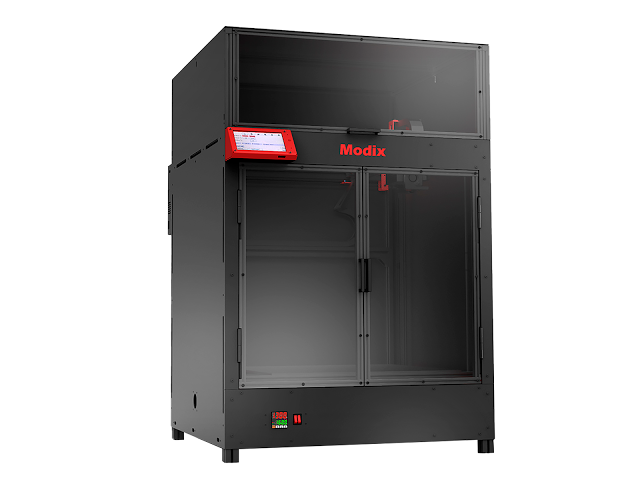
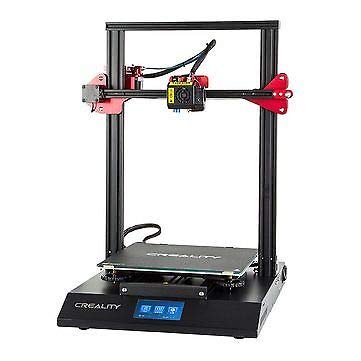

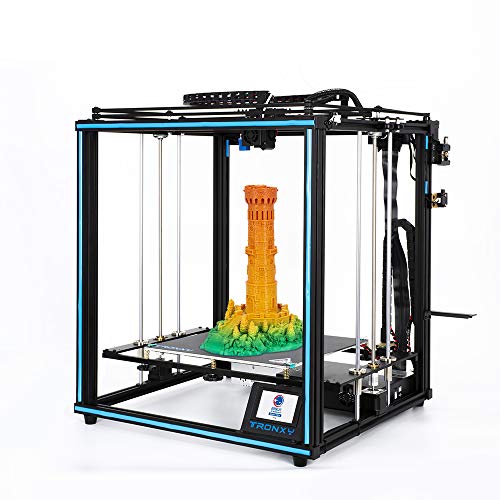
Recent Comments